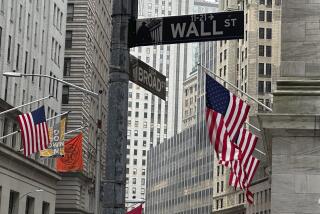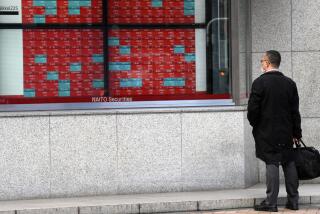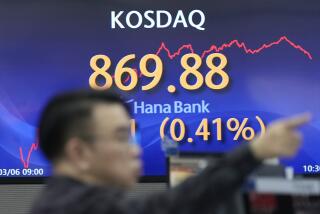Tech stocks once again Wall Street darlings
More than a decade after the dot-com bubble burst, technology stocks are once again the rage on Wall Street.
Shares of companies specializing in social media, mobility, cloud computing, data analytics and location-based e-commerce have surged as much as 60% this year. And fund managers say the stocks have more room to run as demand builds for a new generation of smartphones and other products offering round-the-clock connectivity.
Investors are especially excited about the fast revenue growth — and actual earnings — that many companies have achieved despite their relative youth.
In the last year, LinkedIn Corp., Zynga Inc., Yelp Inc., Groupon Inc.and Angie’s List Inc. have gone public. Wall Street is eagerly awaiting Facebook Inc.’s massive initial public offering, expected in May.Apple Inc.’s stock has climbed 87% in the last year, with some analysts projecting the share price — currently around $634 — could top $1,000.
The excitement over Facebook and other newcomers compares with the more muted gains for old-school tech firms focused on computers, wired networking, televisions and printers.
“It’s the bifurcation of what investors consider mature businesses versus new growth areas, with [the latter] doing much better,” said Matt Schuldt, portfolio manager of Fidelity’s Select Computers fund. “It’s an area that investors have a lot of optimism in.”
The boom is a sharp departure from the late 1990s, when too many companies with unsustainable business models and no profits went public at stratospheric valuations. The dot-com boom gave way to a historic bust that sparked a brutal bear market from 2000 to 2002.
The current tech scene owes much of its resurgence to Apple. Tech analysts and portfolio managers say the 2007 release of the iPhone was a landmark device that not only became a huge revenue producer for the tech giant but also helped create a supporting ecosystem of related products and businesses such as apps, cloud computing and tablets.
“It’s been a good year for tech sector funds in general,” said Flynn Murphy, an analyst at fund trackerMorningstar Inc.”It’s also been a great year for one stock in particular.”
Tech enthusiasts, however, say the good news in the sector extends beyond the maker of iPhones and iPads.
There is “incredible strength besides Apple,” Schuldt said.
Tech funds, which suffered in the second half of last year, were the best-performing sector in the first quarter, Morningstar said.
The average tech fund had roughly 10% of its money in Apple, which boosted returns. Many exchange-traded funds had even larger amounts in Apple — as much as 20%, said Robert Goldsborough, a Morningstar analyst specializing in sector ETFs.
Among the top performers this year: Fidelity’s Select Computers Portfolio, up 24%; T. Rowe Price’s Global Technology Fund, up 23%; Waddell & Reed’s Science & Technology Fund, up 19%; and Allianz’s RCM Technology Fund, up 16%.
Adventurous investors are now eyeing younger tech companies, hoping to capitalize on some of the recent excitement. That’s shifted much of the attention away from larger, more conservative companies such asMicrosoft Corp.,Intel Corp.and evenGoogle Inc.
“The problem in tech is that a lot of the established large-cap companies are under assault,” said David Eiswert, manager of T. Rowe Price’s Global Technology Fund. “All of those giant businesses were built in a different world, and now the rules have changed.”
The good news, he said, is that many large companies, such asCisco Systems Inc.andDell Inc., have refocused their businesses to adapt.
Portfolio managers also note that after a decade of falling price-to-earnings ratios — triggered by investors’ suspicions that tech stocks were overvalued — P/E ratios have stabilized and are starting to rise.
“We’re probably in the late innings of the valuation multiple contraction of the tech sector, and if that’s true, then the tech sector can grow with earnings,” Schuldt said. “So by removing the major headwind of the last decade, investors can actually enjoy the return of the dividends plus the earnings growth and that would obviously create more attractive returns than investors have seen over the last 10 years.”
With so many tech firms emerging, fund managers say investors need to be wary of unproven companies that are riding on hype, such as daily deals site Groupon, which went public late last year and is suffering from a lack of profit amid stiff competition from rivals. Such stocks are generally riskier; Groupon’s shares have plummeted more than 44% since its November IPO.
So Goldsborough said he generally recommends tech ETFs that are broadly diversified. Four of the largest, most liquid and most well-known tech-related ETFs have year-to-date returns of 19% to 21%, he said.
They are Technology Select Sector SPDR (XLK), Vanguard Information Technology (VGT), iShares Dow Jones U.S. Technology Sector (IYW) and PowerShares QQQ (QQQ).
“Those tend to be the ones I think that are the most suitable for the vast majority of individual investors,” Goldsborough said. “We say the subsector-level technology ETFs are good if investors are looking for specific exposure: semiconductors to software to social media. Those make sense for investors who have a very strong level of conviction.”
And Murphy of Morningstar had a note of caution for investors interested in boosting their tech holdings, pointing out that many general portfolios probably already have some tech exposure. For instance, about 20% of the stocks in the Standard & Poor’s 500 index are tech-related, he said, so funds that mirror that index have benefited from the recent sector strength.
“Any time a sector has a run-up, it seems like there’s some interest in whether or not investors are missing out or if they should be participating more in this sector rally,” Murphy said. “We try to remind investors to keep a level head.... It’s one of those things where it’s kind of like recognizing what you might already have before going out to get something that looks new and shiny that might add more volatility to your portfolio.”






